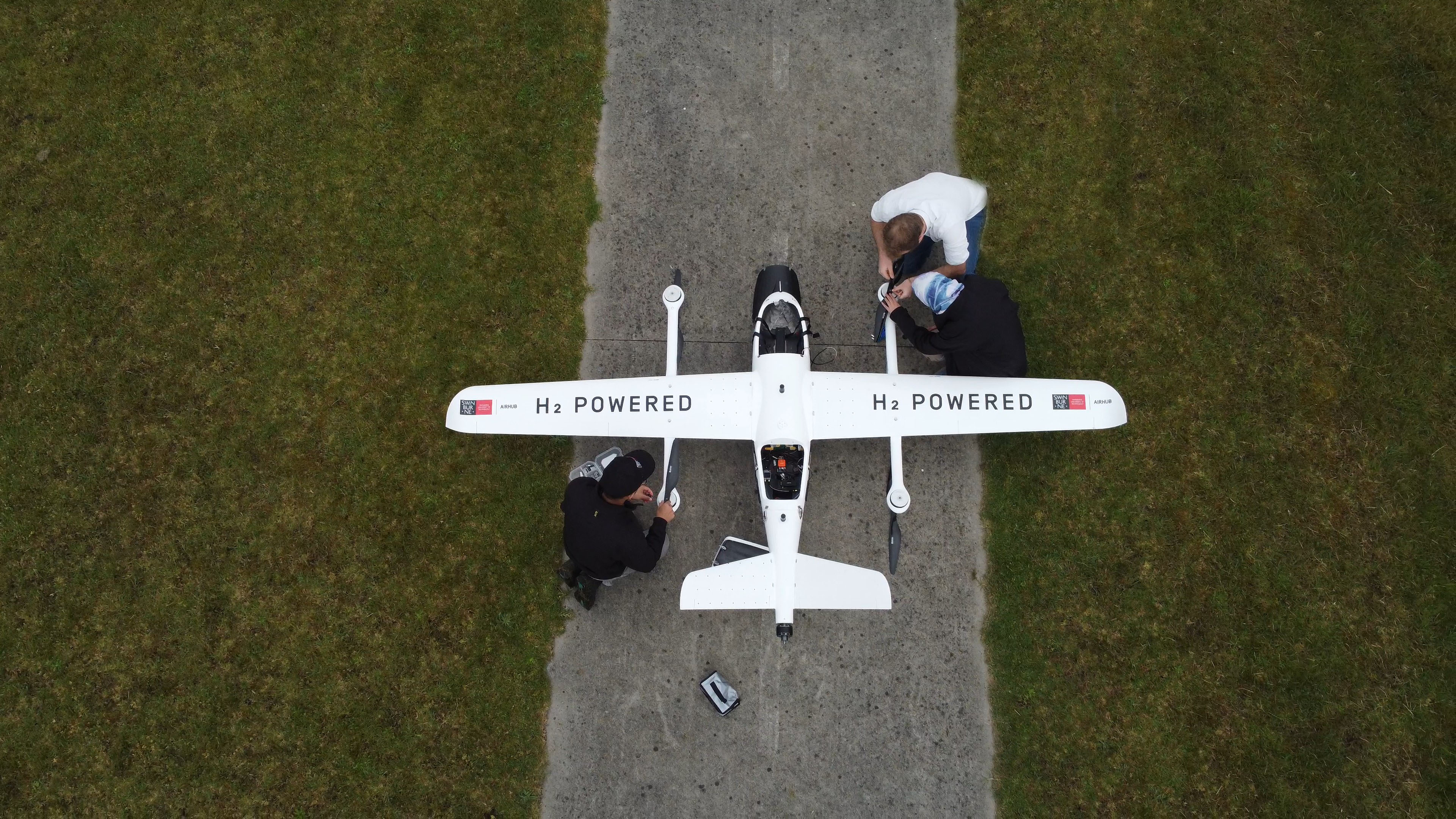Swinburne’s AIR Hub achieves hydrogen flight

The Hydrogen to the Skies team preparing the SHADE drone for its first hydrogen-propelled flight in the Latrobe City Council.
In summary
- Swinburne’s AIR Hub has successfully completed the first flight of an Australian-developed hydrogen fuel cell electric powered VTOL drone.
- The AIR Hub’s innovative SHADE drone is being developed as part of the Hydrogen to the Skies project.
- Hydrogen-propelled uncrewed aircrafts have the potential for significant positive impact on Australia’s supply chain ecosystem, drastically improving access to remote areas of the country.
Swinburne University of Technology’s Aerostructures Innovation Research Hub (AIR Hub) has successfully completed the first flight of an Australian-developed hydrogen fuel cell electric powered VTOL drone. The flight test was achieved using AIR Hub’s innovative Small Hydrogen Aircraft Development & Evolution (SHADE) drone.
This flight marks a significant milestone in Australia’s advanced air mobility (AAM) journey as the first electric vertical take-off and landing (eVTOL), hydrogen-powered uncrewed aerial system (UAS) flight. The successful flight is the result of collaboration with industry partners, researchers and businesses across the aviation and hydrogen industries, including Swinburne’s Victorian Hydrogen Hub (VH2).
The SHADE drone was developed through AIR Hub’s Hydrogen to the Skies (H22S) project, funded by the Australian Commonwealth Government’s Emerging Aviation Technology Partnerships program. The aim of this project is to design and integrate a new hydrogen propulsion system into a large-scale drone to help spearhead the commercial development of clean, zero emissions uncrewed air systems.
The flight occurring last week in Victoria’s Latrobe City Council was the first of its type in Australia. It demonstrates a leap forward in clean aviation, enabling extended range compared to traditionally battery powered UAS, while reducing the environmental impact through sustainably produced hydrogen. This achievement demonstrates Swinburne’s commitment to developing sustainable aviation technologies.
“The successful hydrogen-powered flight of the SHADE drone represents a significant milestone in not only the H22S project, but also the development of net zero aerospace in Australia,” says Dr Adriano Di Pietro, Director of the AIR Hub.
Australia’s net zero AAM future
The success of a hydrogen-propelled flight of the SHADE drone is a significant milestone in the first phase of the multi-phase H22S project.
This will position Australian aerospace and aviation companies to scale up hydrogen use in aviation, with a view to utilise hydrogen propulsion progressively from UAS all the way to passenger and freight air vehicles.
Research being completed by the AIR Hub also speaks to the potential to convert existing internal combustion powered aircraft into emission-free flight.
Hydrogen propulsion will allow longer range regional and remote-area flights than is achievable by battery-powered air vehicles, which are being developed for short-range urban operations. Projects like the H22S project will have significant positive impact on Australia’s supply chain ecosystem, with uncrewed, hydrogen-powered aircraft having the potential to deliver products, including life-saving medications, to some of Australia’s most remote environments.
“Swinburne’s AIR Hub is dedicated to cementing Australia as a key player in the global effort towards the decarbonisation of the aviation and aerospace industry, and we believe that utilising hydrogen power is key to this journey," says Dr Di Pietro.
-
Media Enquiries
Related articles
-

- Technology
- Science
- Engineering
Victorian students drive green energy transition through international hydrogen competition
Swinburne’s KIOSC, in collaboration with Horizon Educational and Gippsland Tech School, co-hosted the Hydrogen Grand Prix in Melbourne.Friday 26 July 2024 -

- Technology
- Health
New MedTechVic prototypes to transform everyday lives of people with a disability
Swinburne’s MedTechVic has revealed three new prototypes designed through the joint Health-led Manufacturing Innovation Program, in partnership with the Australian Medtech Manufacturing Centre and Safer Care Victoria
Friday 19 July 2024 -

- Business
- Technology
Swinburne’s Luminate Pitch Night 2024 advances innovative ideas for a better world
Swinburne’s 2024 Luminate Pitch Night showcased market-ready ideas from 10 founders
Wednesday 12 June 2024 -

- Health
- Technology
Clinical Innovation Fellowships develop creative solutions to Australia’s healthcare challenges
MedTechVic is gearing up to begin its fourth year of the Clinical Innovation Fellowship Program (CIFP), following the highly successful third round in 2023.
Wednesday 19 June 2024 -

- Technology
- Aviation
- Sustainability
Swinburne partners with Latrobe City Council to propel Victoria’s Advanced Air Mobility precinct
Swinburne has become the first Foundation Member of the newly established Latrobe Aerospace Technology Precinct.
Friday 03 May 2024

